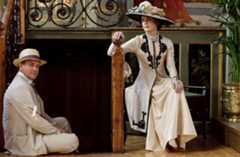How to Address an Earlor Countess
How to Address an Earl
How to Address a Countess
Examples:
—-The Earl Ferrers
—-The Earl of Coventry
—-The Earl of Shrewsbury and Waterford
When an earldom has a compound name,‘(name one)’ of/and ‘(name two)’, usename one when(name) is specified and the full compound name when the (complete name) is specified.
Thegiven name of the titled person is never used in formal address. British style books show the courtesy title abbreviated as shown below.
Robert Hickey author of“Honor & Respect”
—-Envelope or address block on letter or email:
———The Right Hon.
—-—-The Earl (complete name)
—-—-(Address)
—-—-The Right Hon.
—-—-The Countess(complete name)
—-—-(Address)
—-—-The Right Hon.
—-—-The Earl and Countess (complete name)
—-—-(Address)
—-Letter salutation:
—-—-Dear Lord/Lady (name):
– Robert Hickey How to Address an Earl How to Address a Countess
See Below: The Earl and Countess of Grantham, from the PBS SeriesDownton Abbey were addressed asLord Grantham andLady Grantham. Earl andcountess are not used in a salutation or conversation.Photo courtesy © Carnival Productions 2017.

How to Address an Earl, Countess, and Their Sons?
#1) Can an Earl and Countess either be calledEarl of Richland and Countess of Richland, -or- Lord and Lady Richland?
#2)If the father is theMarquess and the son is aViscount, can a father and eldest son both beLord (Surname) at the same time?
#3)I understand that the younger son can be calledLord by courtesy, but please clarify about the eldest son for me.
————————— LBT
Dear LBT:
British titles aren’t easy … unless you are raised with them! The British style books give directions on what to do rather than just the answer … so I wrote my book for those of us who want just the facts and fast.
#1)Can an Earl and Countess either be calledEarl of Richland and Countess of Richland –or- Lord and Lady Richland?
Anearl/countess is addressed in oral conversation as Lord (Name) / Lady (Name). Earl andcountessare use only in written address, Someone might orally refer to the earl/countess by his or her title when speaking about the earl/countess to a third person such as in“the Earl of Richland will be here in 20 minutes.” In spoken address it is Lord (Name / Lady (Name)
#2)Can a father and eldest son both be a Lord (Surname) at the same time?
The(name) in the title may or may not be their surname … So don’t think of it asLord (Surname) think of it as Lord (Name of Earldom). Only the titled person (the father) is addressed asLord (name of title) … so a son would not be addressed asLord based on that title until the title passes, when his father dies … but read the next note.
#3)Maybe the father is theMarquess and the son is aViscount? I understand that the younger son can be called “lord” by courtesy, but please clarify about the eldest son for me.
Actually the father is both theMarquess and theViscount. He is addressed by his highest title and the lower title is not used. So the eldest son(who will be inheriting the titles) can use‘Viscount’ — one of his father’s unused titles — during his father’s lifetime.
There’s a different formula for younger sons … who areHonourable andMr. (Surname) … and have no title to pass on. And yes — in this case(Surname) is their family name.
— Robert Hickey
See these Related Posts:
–—-—King/Queen
–—-—Duke/Duchess
–—-—Marquess/Marchioness
–—-—Earl/Countess
–—-—Viscount/Viscountess
–—-—Baron/Baroness
–—-—Knight/Dame–—-—Noble Titles: Social Use Only
Robert Hickey author of“Honor & Respect”
When Should You Use the Forms on this Page?
You can use these forms of address for any mode of communication: addressing aletter, invitation, card orEmail.(If there are differences between the official and social forms of address, I will have mentioned the different forms.) The form noted in the salutation is the same form you use when you say their name in conversation or when yougreet them.
___What I don’t cover on this site aremany thingsI do cover in my book:all the rules of forms of address, about names, international titles, precedence, complimentary closes, details on invitations, place cards, all sorts of introductions,etc. I hope you’ll get acopy of the book if you’d like the further detail.
Not Finding Your Answer?
—-#1)At right ondesktops,at the bottom of every pageontablets andphones, is a list of all the offices, officials & topics covered on the site.
—-#2) If you don’t see the official you seek included or your question answeredsend me an e-mail. I am pretty fast at sending a reply: usually the next day or so (unless I am traveling.)Note: I don’t have mailing or Email addresses for any of the officials and I don’t keep track of offices that exist only in history books.
—-#3) If I think your question is of interest to others, Sometimes I post the question – but always change all the specifics.
— Robert Hickey
Robert Hickey author of“Honor & Respect”
Recommended Resources: The Protocol School of Washington (PSOW) and Protocol and Diplomacy International – Protocol Officers Association (PDI-POA) For more information see theProtocol Resources page.


